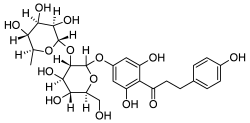- Naringin dihydrochalcone
-
Naringin dihydrochalcone  1-[4-[(3S,4R,5R,6S)-4,5-dihydroxy-6-(hydroxymethyl)-3-[(2S,3R,4R,5R,6S)-3,4,5-trihydroxy-6-methyloxan-2-yl]oxyoxan-2-yl]oxy-2, 6-dihydroxyphenyl]-3-(4-hydroxyphenyl)propan-1-oneOther namesNaringin DC
1-[4-[(3S,4R,5R,6S)-4,5-dihydroxy-6-(hydroxymethyl)-3-[(2S,3R,4R,5R,6S)-3,4,5-trihydroxy-6-methyloxan-2-yl]oxyoxan-2-yl]oxy-2, 6-dihydroxyphenyl]-3-(4-hydroxyphenyl)propan-1-oneOther namesNaringin DCIdentifiers CAS number 18916-17-1 PubChem 25245680 Jmol-3D images Image 1 - C[C@H]1[C@@H]([C@H]([C@H]([C@@H](O1)O[C@H]2[C@@H]([C@H]([C@@H](OC2OC3=CC (=C(C(=C3)O)C(=O)CCC4=CC=C(C=C4)O)O)CO)O)O)O)O)O
Properties Molecular formula C27H34O14 Molar mass 582.55 g/mol Exact mass 582.194856 u Appearance White powder Melting point 169-170°C
 (verify) (what is:
(verify) (what is:  /
/ ?)
?)
Except where noted otherwise, data are given for materials in their standard state (at 25 °C, 100 kPa)Infobox references Naringin dihydrochalcone, sometimes abbreviated to naringin DC, is an artificial sweetener derived from naringin, a bitter compound found in citrus[1].
Naringin dihydrochalcone is a phloretin glycoside discovered at the same time as neohesperidin dihydrochalcone during the 1960s as part of a United States Department of Agriculture research program to find methods for minimizing the taste of bitter flavorants in citrus juices.
When Naringin is treated with potassium hydroxide or another strong base, and then catalytically hydrogenated, it becomes a dihydrochalcone, a compound roughly 300-1800 times sweeter than sugar at threshold concentrations[2].
References
- ^ (English) Raphael Ikan. Natural products: a laboratory guide. Publié par Academic Press, 1991. 360 pages. ISBN 0123705517. Chapitre 1-Flavonoides, E. Synthesis of Naringin Dihydrochalcone— A Sweetening Agent. pages 17-18.
- ^ (English) P Tomasik, Chemical and Functional Properties of Food Saccharides, CRC Press, 2003, 440 p. (ISBN 9780849314865), p. 389
Dihydrochalcones: 3′,5′-dihydroxy-2′,4′,6′-trimethoxydihydrochalcone | 2′-hydroxy-3′,4′,5′,6′-tetramethoxydihydrochalcone (dihydrokanakugiol) | 2′-hydroxy-3′,4′,5′,6′-tetramethoxychalcone (kanakugiol) | 5-hydroxy-6,7,8-trimethoxyflavone (alnetin) | methyl linderone | 2′,3′,4′,5′,6′-pentamethoxychalcone (pedicellin) | Phloretin | Pinocembrin chalconeDihydrochalcone glycosides: This article about a natural phenol is a stub. You can help Wikipedia by expanding it.
